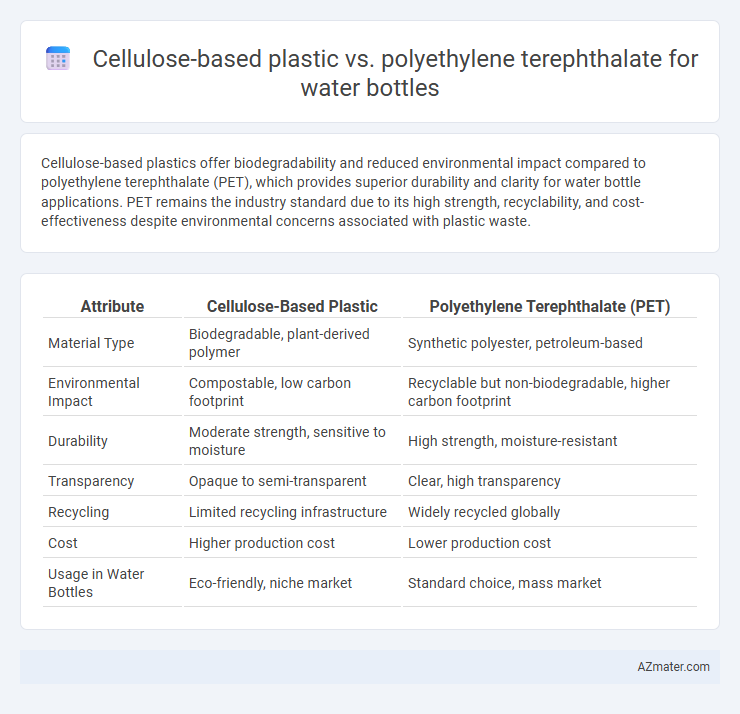Cellulose-based plastics offer biodegradability and reduced environmental impact compared to polyethylene terephthalate (PET), which provides superior durability and clarity for water bottle applications. PET remains the industry standard due to its high strength, recyclability, and cost-effectiveness despite environmental concerns associated with plastic waste.
Table of Comparison
| Attribute | Cellulose-Based Plastic | Polyethylene Terephthalate (PET) |
|---|---|---|
| Material Type | Biodegradable, plant-derived polymer | Synthetic polyester, petroleum-based |
| Environmental Impact | Compostable, low carbon footprint | Recyclable but non-biodegradable, higher carbon footprint |
| Durability | Moderate strength, sensitive to moisture | High strength, moisture-resistant |
| Transparency | Opaque to semi-transparent | Clear, high transparency |
| Recycling | Limited recycling infrastructure | Widely recycled globally |
| Cost | Higher production cost | Lower production cost |
| Usage in Water Bottles | Eco-friendly, niche market | Standard choice, mass market |
Introduction to Water Bottle Materials
Cellulose-based plastics, derived from renewable plant fibers, offer a biodegradable and sustainable alternative to conventional plastics for water bottles, reducing environmental impact through natural decomposition. Polyethylene terephthalate (PET), a petroleum-based polymer, dominates the market due to its excellent clarity, lightweight nature, and strong barrier properties that preserve water quality. Both materials represent contrasting approaches: cellulose-based plastics prioritize eco-friendly sourcing and end-of-life biodegradability, while PET emphasizes durability, recyclability, and widespread manufacturing infrastructure.
Overview of Cellulose-Based Plastics
Cellulose-based plastics, derived from plant fibers such as wood pulp or cotton, offer a biodegradable and renewable alternative to conventional petroleum-based plastics like Polyethylene Terephthalate (PET) used in water bottles. These bioplastics exhibit excellent oxygen barrier properties, improving the shelf life of beverages while reducing environmental impact through enhanced compostability and reduced carbon footprint. Innovations in cellulose nanocrystals and cellulose acetate formulations further enhance mechanical strength and clarity, making cellulose-based plastics increasingly viable for sustainable packaging solutions.
Understanding Polyethylene Terephthalate (PET)
Polyethylene terephthalate (PET) is a widely used thermoplastic polymer in the production of water bottles due to its high strength, lightweight nature, and excellent barrier properties against moisture and gases. PET is derived from petrochemicals and is highly recyclable, undergoing multiple reprocessing cycles while maintaining material integrity. Its clarity, durability, and resistance to microbial contamination make PET the preferred choice over cellulose-based plastics in commercial water packaging.
Environmental Impact Comparison
Cellulose-based plastics, derived from renewable plant fibers, offer significantly lower carbon footprints and enhanced biodegradability compared to polyethylene terephthalate (PET), which is petroleum-based and contributes to microplastic pollution. While PET is widely recycled, its production emits considerable greenhouse gases and persists in the environment for centuries, causing long-term ecological harm. The environmental benefits of cellulose-based plastics include reduced fossil fuel dependency and faster degradation rates, making them a more sustainable option for water bottle packaging.
Biodegradability and Recycling Potential
Cellulose-based plastics offer superior biodegradability compared to polyethylene terephthalate (PET), breaking down naturally in composting environments within months, whereas PET can persist for centuries in landfills. PET dominates recycling streams due to established infrastructure, enabling efficient mechanical and chemical recycling processes that produce high-quality recyclates for new bottles. Despite PET's recycling advantages, cellulose-based plastics provide environmental benefits by reducing microplastic pollution and supporting circular bioeconomy initiatives through their renewable, plant-derived composition.
Manufacturing Processes and Resource Efficiency
Cellulose-based plastics for water bottles are derived from renewable biomass such as wood pulp, involving chemical treatments like esterification to convert cellulose into bioplastic with biodegradability advantages, while polyethylene terephthalate (PET) is synthesized from petrochemical feedstocks through polymerization of ethylene glycol and terephthalic acid, relying on non-renewable fossil fuels. The manufacturing process of cellulose-based plastic is generally more energy-intensive due to complex purification and modification steps but offers a lower carbon footprint and enhanced biodegradability compared to PET's energy-efficient production process that prioritizes durability and recyclability. Resource efficiency favors cellulose plastics for renewable sourcing and biodegradability, whereas PET excels in material robustness and well-established recycling infrastructure, making lifecycle assessments critical for sustainable water bottle production choices.
Material Properties: Strength, Weight, and Durability
Cellulose-based plastic for water bottles offers high biodegradability and a renewable origin with moderate strength and light weight, making it environmentally favorable but less durable under prolonged stress. Polyethylene terephthalate (PET) exhibits superior tensile strength, excellent impact resistance, and lightweight characteristics, ensuring long-term durability and structural integrity for water bottles. PET's resistance to water and chemicals surpasses that of cellulose-based plastics, contributing to its widespread use in durable, lightweight packaging solutions.
Safety and Chemical Leaching
Cellulose-based plastics exhibit superior safety profiles due to their natural origin and biodegradability, reducing the risk of harmful chemical leaching into water compared to Polyethylene terephthalate (PET). PET bottles can potentially release antimony and other plasticizers, especially when exposed to heat or sunlight, raising concerns over long-term health impacts. Scientific studies indicate cellulose-based materials minimize chemical migration, making them a safer alternative for water bottle packaging in terms of human health.
Market Availability and Cost Analysis
Cellulose-based plastics for water bottles are gaining traction due to their biodegradability and renewable sourcing, but currently have limited market availability compared to polyethylene terephthalate (PET), which dominates global packaging with widespread distribution and established production infrastructure. Cost analysis reveals cellulose-based plastics generally incur higher manufacturing expenses due to raw material processing and lower economies of scale, while PET remains cost-effective because of mature technologies and abundant petrochemical feedstocks. Market trends indicate gradual growth in cellulose-based plastics driven by regulatory pressures and consumer demand for sustainable alternatives, though PET maintains a significant cost and availability advantage.
Future Trends in Sustainable Water Bottles
Cellulose-based plastics offer a biodegradable alternative to polyethylene terephthalate (PET), which dominates water bottle production but contributes significantly to plastic pollution due to its slow decomposition. Future trends in sustainable water bottles emphasize increasing the use of cellulose-derived materials that reduce carbon footprint and enhance compostability without sacrificing durability or clarity. Innovations in bio-based polymers and improved recycling technologies aim to balance performance with environmental responsibility, driving a shift from PET to more eco-friendly, cellulose-based solutions in the beverage packaging industry.

Infographic: Cellulose-based plastic vs Polyethylene terephthalate for Water bottle
 azmater.com
azmater.com